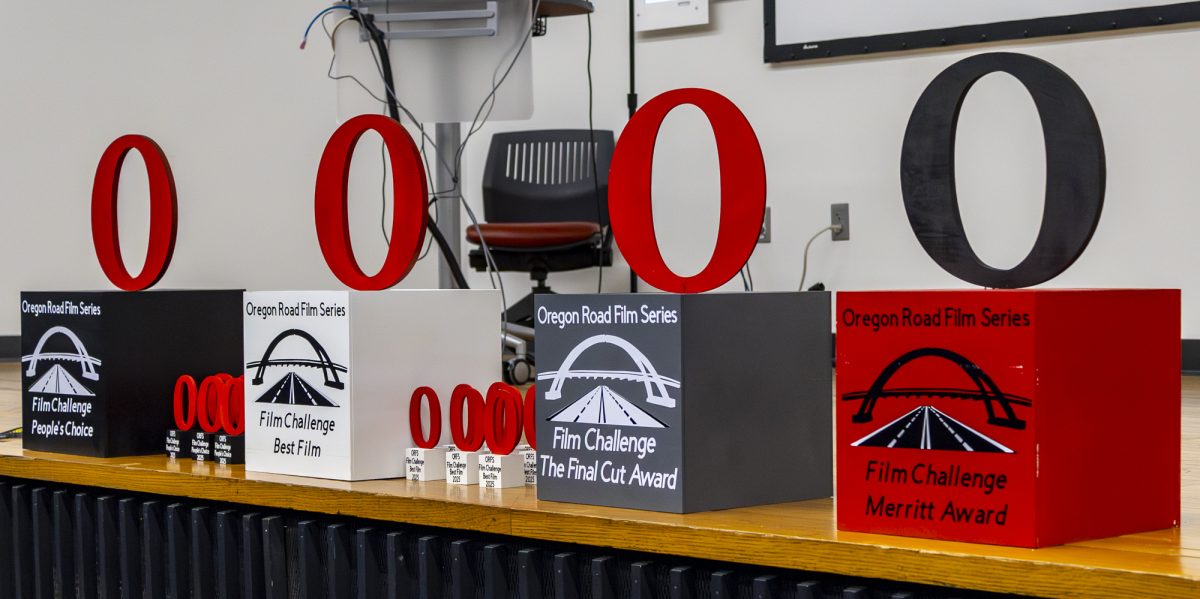Oppenheimer, directed by Christopher Nolan, is now coming to streaming services including Peacock this month. It was a critical and commercial success and well worth your time to watch. It was the third top grossing movie of 2023 with 951 million dollars worldwide. This is especially notable given its dark theme and long running time.
The film itself is also visual and auditory experience. The most striking visual element of the film is that portions of the film are depicted in black and white and other portions are in color. This gives the audience two totally different perspectives of these portions of the film. The black and white portions are presented in severe contrast of dark and light. The color portions are presented in warmer, softer light. There is also a strong visual element of space. A good example of this is the small, cramped room where Dr. Oppenheimer appears before the Personnel Security Board. By having this take place in a small room with many people, the audience gets an added sense of tension in the scene.
There are other visual techniques that are used skillfully. The director, Christopher Nolan, intersects the story of the film with more abstract visual images. One example is when Dr. Oppenheimer is in school, lying in his bed and the film cuts to images of stars and galaxies, to reflect his idealistic, imaginative nature at the time. As he becomes a professor of quantum physics at the University of California Berkeley, the depiction of him instructing the students is interspersed with images of the scientific elements fusing together.
In addition to the dramatic visual elements, the film also makes use of auditory techniques. The interjections of abstract images in the film are accompanied by abstract noises that grab the attention of the viewer. There are two other examples of auditory techniques that the director uses to capture the audience’s attention and relay a message. When the bomb is being tested, there is a nearly thirty second passage of complete silence, with only the visual of the red fireball and the mushroom cloud in the distance. Then the full sound of the blast is heard, to a jarring effect. Nolan uses this technique again when Dr. Oppenheimer is speaking in a high school gym.
The silence then is to convey to the audience Dr. Oppenheimer’s unease with his newfound fame and his apprehension about building the bomb. After the silence, the director once again exposes the audience to the full volume of the cheering crowd. This depicts Dr. Oppenheimer’s increased uneasiness.
The director skillfully uses both visual and auditory elements in the film for several purposes. The color and black and white elements delineate distinct aspects of the story. Abstract visual and sound elements grab the audience’s attention and convey the character’s emotions. It is filmmaking techniques like this that make Oppenheimer a compelling and entertaining film throughout, even with its longer running time and heavier subject matter.
In addition to the visual and auditory experience, Oppenheimer also had some exhilarating performances. Cillian Murphy was both well rounded and dynamic as Dr. J. Robert Oppenheimer. He portrayed almost the full lifespan of the character, going from a young idealistic student to a more jaded adult and finally an elderly man. He made the character believable at all these stages, even with the film’s nonlinear structure.
Robert Downey Jr, as Rear Admiral Lewis Strauss, also had some evolution, and he portrayed his villainous character expertly. Filmed almost completely in severe black and white, he really conveyed his anger and frustration during his Senate confirmation for Secretary of Commerce. His harsh and self-centered portrayal of Strauss is an excellent contrast with Murphy’s idealistic Dr. Oppenheimer.
There was also a dramatic contrast in the portrayal of the two female lead characters. Emily Blunt played J. Robert’s wife Kitty Oppenheimer. This was a great multifaceted performance. On one hand, Kitty could be fiercely loyal and supportive of her husband. On the other hand, she could also be self-centered and narcissistic, even to the point of not caring for her own children. Emily Blunt did a masterful job of balancing both aspects in her portrayal of the character.
Florence Pugh played Jean Tatlock, who was Dr. Oppenheimer’s love interest. Her character was shown as warm and loving, in contrast with the cold and severe Kitty. Publicly, Jean is portrayed as a strong independent woman. When she is alone with Oppenheimer, she is vulnerable and passionate. Florence Pugh does an excellent job of showing both sides of this character.
Oppenheimer is a commercially successful and critically acclaimed film. It uses visual and auditory techniques to engage the audience and convey its message. The performances in the film are both skillful and multifaceted. In addition to its financial achievements, it also won great critical acclaim. It received a 93 score on Rotten Tomatoes.
The local community also appreciated Oppenheimer, and its director, Christopher Nolan. The movie played to packed houses in Toledo, Perrysburg, and Maumee last summer. Owens Community College Film and Theater Professor Chloe Whiting Stevenson said this about the director: “Christopher Nolan utilizes extreme depth when bringing films such as The Dark Knight, Inception, Interstellar, and Oppenheimer. He uses non-linear timelines, complex storylines, and music to heighten the drama. The content of his films is often layered and benefits from multiple viewings in order to analyze and process the content. His work is recognized to be epic in scale and scope, which leads to excellent conversations post-viewing.”
The film has also won several important awards in filmmaking. At the Golden Globes, it won Best Picture-Drama, Cinematic and Box Office Achievement, Best Director, Best Screenplay, Best Score, Best Performance by a Male Actor and Best Supporting Performance by a Female and Male actor. At the SAG Awards, Oppenheimer took most of the top film prizes. It also won the award for Best Actor, Best Supporting Actor, Best Cinematography and Film Editing, Best Music (Score), Best Director, and Best Picture at the Academy Awards. This is an excellent film and more than worth watching.

























